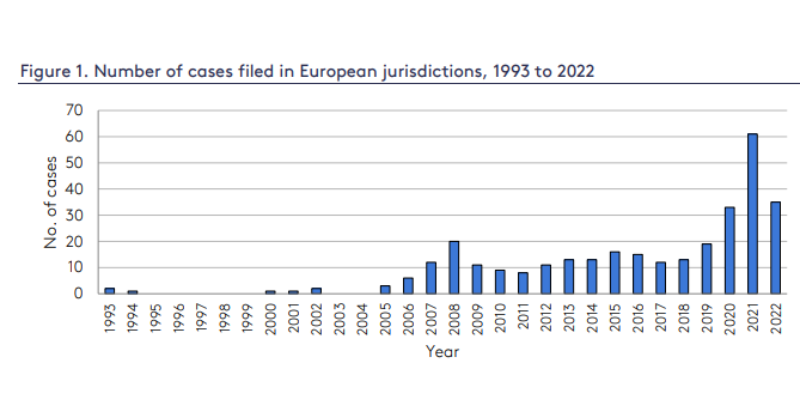
More climate change law is coming
In a world of climate & biodiversity "sticks and carrots", the law is a clear stick. But, we argue that the law is not just about action by governments and regulators. Climate and biodiversity litigation by private citizens and pressure groups is on the rise.
Summary: In a world of climate and biodiversity "sticks and carrots", the law is a clear stick. But, we argue that the law is not just about action by governments and regulators. Climate and biodiversity litigation by private citizens and pressure groups, and by companies, is on the rise, and investors and sustainability professionals ignore this at their peril. Change is not just coming, its already happening.
Why this is important: Litigation is on the rise. Upcoming measures such as the 'Fit for 55' package are likely to become a major driver for new cases.
The big theme: Many investors and companies look at environmental and biodiversity legal risk as coming from actions by governments, and their various regulatory arms. This can include the various environmental agencies, financial regulators and via "reporting" requirements such as the EU taxonomy. While these are important, their weakness as a mechanism for driving change is that they rely on the various parts of government for their enforcement, which can be slow & cumbersome. But, there is increasingly another mechanism - private citizens and lobby groups using litigation to force change. This can happen more rapidly, and its increasingly having a real world impact.

The details
Summary of a report from The Grantham Research Institute
Catherine Higham, Joana Setzer, Harj Narulla and Emily Bradeen: What do new EU climate laws mean for the courts? - March 2023
Europe is undergoing an unprecedented shift in the scale and ambition of climate policy following the announcement of the European Green Deal and the passage of the European Climate Law. There is a significant history in Europe of climate litigation being used as a lever to influence the outcomes and ambition of climate policy. Over the past three decades a broad array of litigants has used European legislation in a range of climate change cases.
We anticipate an increase in climate litigation cases as a result of recent and ongoing legislative efforts at the EU level. In particular, significant litigation is likely following the introduction of the ‘Fit for 55’ package, the European Union’s flagship decarbonisation measures. Much of this litigation is likely to involve challenges to government action or inaction.
Why this is important
Just a quick point. I am not a lawyer, my views on this topic come from three decades of dealing with companies and evaluating investment risk. Nothing in this blog should be interpreted as legal advice. Ok, now we have got that out of the way. As a financial analyst, my early perspective on legal risk related to what actions the various government enforcement agencies might take regarding breaches of the law, and the likely financial (and reputational) consequences. In most cases these were fines (for actions such as corrupt payments, pollution, and worker safety and rights), although in the Pharmaceutical industry, increased monitoring also played a role. The cynical view was that in many cases a deal would be done, companies would pay a reduced fine, agree to make operational changes, but not accept liability or fault.
But, that is now an outdated perspective. In many cases one of the real catalysts for change is a combination of governments passing new laws and regulations and then litigation being used by citizens and NGO's as a tool for compliance. Our focus today is on actions from what the Grantham report calls "citizen applicants", which covers both individual citizens, but also legal persons, so companies, and NGO's. The focus here is on Europe, but we are seeing similar trends in other regions.

"A key trend in the litigation documented since 2015 has been the growth of ‘strategic’ litigation. Strategic cases can be understood as cases that seek to use the courts and the law to generate social change. Such cases are typically accompanied by media campaigns and are frequently brought or supported by advocacy groups and NGOs who seek to use the case to initiate a broader discussion. Even where such cases are unsuccessful before the courts, they may have significant impacts on the climate governance debate in the countries where they are brought" Grantham Institute report March 2023
Litigation is on the rise. We saw what turned out to be a small peak in 2008 as the EU ETS (the region's carbon pricing system) was moving into its second phase, before the recent surge that started c. 2019.

Not all, or even most, of the litigation is from NGO's. Anti-climate litigation often has considerable impact on climate policy. At the EU level, this has previously played out in the case of Air Transport Association of America v. Secretary of State for Climate Change. The case was brought before the UK courts following the adoption of amendments to the Directive establishing the European EU Emissions Trading System that would have seen international aviation included in the system. While the judgement ended up being unfavorable, it formed part of a wider lobbying process that resulted in significant political success.
And upcoming measures such as the "Fit for 55 package" are likely to become a major driver for new cases. The package – a set of interconnected legislative proposals – forms the primary mechanism by which the Commission intends to meet Europe's updated 2030 targets. According to the Commission the package consists of at least 13 measures, including five new legislative acts, and amendments to eight pieces of existing legislation. Key measures from a litigation perspective include the extension of the EU ETS, the enforcement framework for climate targets, the Just Transition legislation, and moves to define low-carbon energy.
Looking beyond Fit for 55, we also have new legislation coming up on corporate governance, supply chains, consumer protection measures, moves to facilitate sustainable capital allocation, and the definitions around climate (green) washing. Just picking one - the scope of the supply chain legislation looks like it will be very broad.
"according to the current draft, the EU Supply Chain Law will apply to: EU companies that are ‘very large’ (i.e. with more than 500 employees on average and a net worldwide turnover of more than €150 million), or that are ‘large and have high-impact’ (i.e. with more than 250 employees and a global turnover of €40 million, provided that at least €20 million was generated by high-risk sectors, including textiles, agriculture, food, metals and mineral extraction). It will also apply to non-EU companies with a turnover of more than €150 million in the EU, or that have over €20 million generated in a high-risk sector and thus can be understood as extra territorial in nature"
I don't know about you, but that sounds pretty all encompassing.

What do investors, companies and sustainability professionals need to do now. To quote the Grantham report yet again
We will be digging down into each of the various pieces of proposed legislation over the coming months, but for now our message is clear - all of us involved in the wider sustainability debate need to build up our understanding. This is too important to just leave to the lawyers.
Something a little more bespoke?
Get in touch if there is a particular topic you would like us to write on. Just for you.
Contact us
Please read: important legal stuff.


